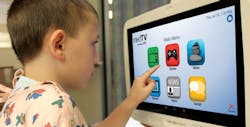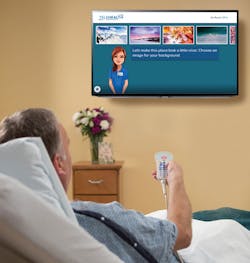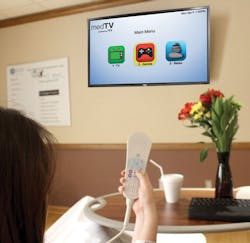Let’s face it: Few want to go to a hospital, doctor’s office, ambulatory surgery center, imaging center or clinical laboratory, save perhaps for those actually working in those facilities for a living to serve patients as their calling.
Unfortunately, we’re all destined to get sick, injured and eventually die with periodic (if not annual) preventive maintenance-as-wellness-check-ups carefully distributed between those three tentpoles in the three-ringed circus of life.
Surrendering to that inevitable reality then, we’re left with the obvious: If we absolutely have to participate in the healthcare experience (and economists, financial wizards and industry reformers all insist that it’s necessary to cut costs and improve quality these days) then we have to resign ourselves to demands for and expectations of a “happy” experience.
Sourcing satisfaction
Happiness in a hospital setting can be translated into minimizing, if not eliminating, any and all of life’s inconveniences. In today’s self-centered “what have you done for me lately?” versus “that was yesterday, this is now” instant-gratification, attention/focus-challenged culture, healthcare organizations seek and strive to source and acquire those products and services that stress (wait, wrong word) … emphasize … convenience and comfort.
The shopping list can include unfettered interactive online access in patient and waiting rooms, high-tech video monitors, communication devices that summon doctors and nurses with haste or inject pain-killing drugs quickly, educational but entertaining videos on simple steps for billing and pricing to name a few.
Much of patient engagement (and satisfaction for near-immediate access to information) centers on automation and electronics — namely telehealth/telemedicine ranging from physician appointments via computer, flat-screen television or mobile/smart phone to text reminders for taking meds, wearable sensors and “robotic” doctor visits along the lines of InTouch Health’s array of technology. (Editor’s Note: See November 2005 HPN.)
Just like Supply Chain professionals want to buy the fewest number of products at the lowest possible prices, while suppliers want to sell the most products at the highest possible prices, patients want to spend the fewest amount of convenient, pain-free days in the hospital and not worry about paying a dime because the insurance company will take care of everything.
As a result, Supply Chain executives and professionals have their work cut out for them as these product categories may more covertly tied to the organization’s revenue stream than what they’re used to sourcing.
From high-tech kiosks and touchscreen panels to nifty apps and web portals to wearable sensors and communication devices to virtual versus actual procedures to physician robots and product bundles for home, Supply Chain may be pushed outside of its comfort zone that includes the traditional medical/surgical, laboratory and pathology, radiology, cardiology, orthopedics and other traditional product and service categories. These “more contemporary” areas remain a bit less specialized but closely tied to patient satisfaction scores that can determine the extent of payer reimbursement.
Patient perceptions
Clearly, it’s a whole new world to explore out there. Of course, some may argue that the world really hasn’t changed. The difference now is that healthcare organizations are being held accountable for this behavioral trend and being compensated for customer service impressions and reactions via patient surveys.
To wit, one study found that more than 80 percent of consumers surveyed expressed dissatisfaction with their healthcare experience and, perhaps not surprisingly, “the happiest are those who interact with the system the least,” according to “Making the Shift: Healthcare’s Transformation to Consumer-Centricity,” written by a quartet of executives from Prophet, a global consulting firm that specializes in brand and customer experiences, business development and digital applications.
“Anyone who has interacted with the healthcare industry is familiar with its faults,” Prophet’s observers cogently wrote. “Insurance plans full of jargon that no one understands, long wait times for appointments and procedures, bills that arrive in the mail months after a visit, lack of coordination between physicians, insurers and pharmacies. Consumers want healthcare to be convenient, connected and tailored to their own needs. They want and expect seamless experiences and solutions that make their lives easier, not more complicated.”
Another study published in the June 2018 edition of the journal Health Affairs stated that in 2015, 92 percent of U.S. adults ages 35 and up had “received all of the high-priority, appropriate clinical preventive services recommended for them.”
No surprise then when and why clinical and professional associations, including the American Medical Association, American Hospital Association, and others, wisely call for an accessible, integrated, mobile healthcare system.
Ultimately, patients seek to be escorted through their entire experience that begins with the “medical home” concept promoted at the recent AHRMM conference in Chicago by Jimmy Chung, M.D., Associate Vice President, Perioperative Services, Providence St. Joseph Health, whereby caregivers help the patient “warm up” and coach for admission. This is followed by admission as an inpatient, then pre-op planning, surgery, recovery, post-op planning and then post-discharge coaching and follow-through, all of which feed into the continuum of care and population health. (Editor’s Note: Be sure to read next month’s story exploring “Strategic Sourcing for the Care Continuum,” November 2018 HPN.)
Such decisions may be made and implemented by clinicians and administrators, but another group is left to fulfill and sustain them. Supply Chain may be chief among those key supporters.
Product procurement
What are some of the key products and technologies that can engage patients, encourage them to participate in the care they receive and make them appreciate the caregiver and facility enough to rate them highly for reimbursement? The options include apps and software, equipment and to some degree, furniture.
“The use of technology — electronic tablets (e.g., iPad), electronic health records, remote monitoring applications and digital/ wireless connectivity — are foundational for delivering seamless care to our patients regardless of where they are,” said Vance Moore, President, Business Integration, Mercy. “Through continuous monitoring and engaging with the patient on-going we are able to reduce episodic care, unnecessary interventions and improve outcomes; thereby improving quality of life and helping the patient and their caregivers by delivering proactive care as opposed to reactive treatment that is resulting in a 98 percent patient satisfaction rate.”
Mercy operates a telehealth-driven and infused enterprise called “Mercy Virtual” that electronically “touches” patients as customers within and outside of the organization’s four walls.
Electronic tablets allow for real-time face-to-face interaction between the care provider and the patient, for the prover to lay eyes on the patient and provide a physical assessment, Moore told Healthcare Purchasing News. Electronic health records provide the patient history, health trends, care pathway and the ability to track all patient interactions so that any provider can pick up the care seamlessly from anywhere. Remote monitoring is critical as the ability to monitor and analyze the data from the patient to allow for early detection, intervention and improved outcomes, Moore indicated.
Lisa Romano, RN, Chief Nursing Officer, CipherHealth, agrees that information technology access makes a difference in engaging patients and helping their journey through the care continuum more pleasant.
The list includes CipherHealth’s app for rounding, outreach and recording; a variety of equipment, such as iPads, Android devices, kiosk hardware, which can be boxes that encase iPads; stand-up furniture to hold the kiosks, television sets for display education, whiteboards in the patient rooms and sophisticated over-bed tray tables either on wheels or wall-extended swing arms, according to Romano. Before joining CipherHealth, Romano spent 19 years as a nurse and hospital administrator at Lehigh Valley Hospital and Health Network in Allentown, PA, where she was responsible for all patient flow and transfer center operations as well as numerous quality and patient satisfaction initiatives. She brings more than 25 years of clinical practice, healthcare IT strategy and healthcare operations experience to her current role.
Software would require Supply Chain partnering with IT, Romano noted. “IT would manage the integrations and C-suite decision, but Supply Chain may be the influencer as they work to put tools in the hands of patients to educate and engage them,” extending beyond their traditional equipment model and expanding their reach, she added.
CareThrough, a subsidiary of HealthChannels, makes artificial intelligence (A.I.) “chatbots,” chronic care management (CCM) programs and committed “human” navigators to engage patients in their treatment paths, recognizing a clear shift in trends, according to Kyle Cooksey, President.
“Patients expect more from their healthcare providers in today’s connected, digital environment,” Cooksey said. “Our mission at CareThrough is to right-size care teams to allow doctors, and care teams to work more efficiently. We also provide AI technology to increase patient engagement and improve satisfaction scores at the point of care, which is critical for ensuring the most optimal outcomes are reached.”
CareThrough’s LifeLink tool provides health systems with conversational AI chatbots designed to improve the relationship between patient and provider, Cooksey noted. “LifeLink provides a virtual assistant that is more robust than a delayed flight alert, or banking balance update you may receive via text,” he said. “The LifeLink-powered AI is conversational, and designed specifically to improve the patient experience. Care teams configure chatbots to streamline communication with patients. LifeLink is designed to be effective in multiple healthcare settings, from emergency rooms to outpatient facilities. Care teams are able to rapidly customize and deploy conversational chatbots. And for CFOs it’s also important that the technology is affordable, and improves patient engagement. If a patient arrives at the Emergency Department, we are able to send approximate wait times, and if they are waiting on labs, we can send a text message to the patient letting them know the results are available to review.
“What we learned from our research is that the common denominator between an 18-year-old patient and a 70-year-old patient is that they are both using text messaging,” Cooksey continued. “Consumers download apps, and delete them at an alarming rate. That’s why health systems look to LifeLink to drive engagement better than patient portals and apps. The key to our user-friendly technology are the chatbots’ intuitive communication.”
Richard Bootes, Vice President of Product Development, TeleHealth Services, recognizes the shift in customer focus, too.
“True patient engagement begins with an understanding that each patient is unique,” Bootes said. “We need to learn about patients as individuals and know how to personally motivate them to take an active role in managing their health.”
TeleHealth Services develops interactive technology that engage and educate patients and families in hospitals using either the patient television or a bedside tablet, Bootes noted. “Typically, a care team spends less than 10 minutes with patients prior to discharge in delivering instructions and stacks of paper handouts, he continued. A revolving door of readmissions contributes to escalating healthcare costs. We developed iCare Navigator to provide a new paradigm of engagement and health education with patients and families.”
iCare Navigator is the “first enterprise-scale interactive patient engagement platform for hospitals using artificial intelligence and virtual health coaches (avatars) to create a more personalized relationship with the patient,” according to Bootes. “The system combines empathy, game theory and family involvement using video, audio and imagery to drive positive patient behaviors. iCare Navigator was inspired by Project Re-Engineered Discharge research at Boston University where patient satisfaction surveys revealed that twice as many patients actually prefer interactions with avatars than with human doctors and nurses.
“By fully integrating with EMRs and other clinical and non-clinical systems, iCare Navigator engages patients and families across the patient journey and helps them become more active participants in their own care,” Bootes said. “As the patient interacts with the virtual health coach, workflow decisions are automatically made based on the patient’s engagement level. iCare Navigator measures responsiveness, mood, and receptiveness to learning, and determines optimal times for delivering patient education content. Patients can also use the system to make service requests or order meals using the TV or tablet providing additional conveniences that foster greater patient satisfaction.”
PDi concentrates its product and service efforts on the in-room television, which tends to be the secondary focal point within the patient room behind the primary one — the patient, according to Cat Saettel, Marketing Manager, PDi Communication Systems Inc. PDi’s “medTV” touchscreen sets include pillow speaker controls for a digital interactive experience that are compatible with “many leading enterprise-based interactive patient software systems” and can include internet-enabled features if desired, Saettel added.
“Patients often feel the only thing they have control over is their hospital room television!” Saettel said. “Delivering a high-quality TV experience that offers modern app-based technology and current TV programming is the simplest solution to satisfy patients, with minimal staff time investments. PDi integrates eight game apps and three relaxation apps out-of-the-box. Who doesn’t enjoy a bit of distraction with fun trivia? Also, research shows that soothing nature sounds help patients rest well and heal faster. With a simple touch or navigational clicks on the pillow speaker, the patient can switch from regular TV programming and fill their room with the sounds and images of rushing streams, relaxing waves, or soft rain to help ease anxieties, deter patients from dwelling on health news they may receive during the hospital stay, and drown out disruptions from other sounds in the hospital surroundings.”
TeleHealth Services also provides healthcare-grade televisions and patient bedside tablets, entertainment and educational content, television network infrastructure, digital signage and wayfinding systems, and audio/visual systems integration for collaborative communications that improve the patient, staff and visitor experiences, according to Bootes.
“While at home, people watch TV an average of six hours a day,” Bootes indicated. “In a hospital, TV viewing increases to almost 11 hours each day. Hospitals are investing in an infrastructure that provides quality entertainment on high-definition televisions, creating an entertainment experience similar to what patients and families have when they are at home.
“Innovative systems and technology infrastructure in patient rooms and throughout a hospital strategically differentiates services and creates a more satisfying patient experience,” Bootes continued. “The investments in Smart TVs and interactive patient engagement systems improve care, support financial reimbursements, increase patient safety and HCAHPS patient satisfaction scores resulting in better health outcomes and reduced readmissions.”
About the Author
Rick Dana Barlow
Senior Editor
Rick Dana Barlow is Senior Editor for Healthcare Purchasing News, an Endeavor Business Media publication. He can be reached at [email protected].






